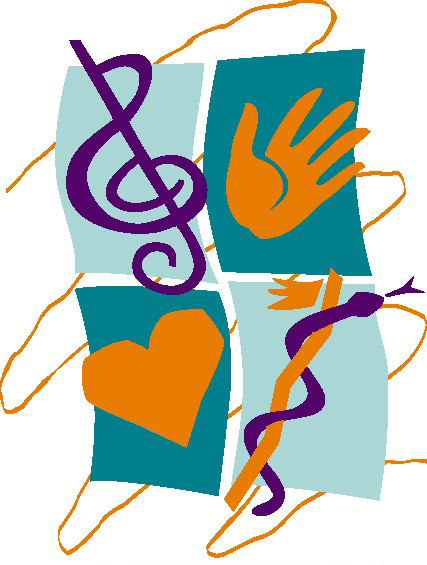Focus on ways to relax and regulate body
- Find ways to help the youth relax and regulate their body. These interventions can include art, drama, sports, martial arts, music therapy, equine therapy, occupational therapy etc.
- Consider creating a calming toolkit that includes simple self-regulation options. This would be a personalized self-care or resiliency toolkit/checklist that the youth carries with them or post the checklist somewhere prominent (bathroom mirror). It could include words or pictures of the calming things that they prefer. For example:
- Words like “I am here. I am safe. I am okay right now.”
- A simple breath awareness technique like exhaling through pursed lips.
- Physical activity and exercise.
- If the youth needs sensory regulation, consider prioritizing physical activity and exercise be a part of the daily routine. Include activities that provide proprioceptive input that can be calming and organizing to the sensory system. This includes running, jumping, pushing , pulling, yoga, or other types of ‘heavy work’. Swinging, spinning or other vestibular input should only be directed by the youth and never imposed by others as it can overwhelm the sensory system.
Support for Sensory Needs & Regulation
- Teach self-regulation and/or co-regulation, along with coping strategies.
- Encourage the identification and expression of feelings by applying social and emotional learning (SEL) strategies.
- Use portions of Zones of Regulation Curriculum to teach simple self-regulation skills (sensory based strategies or “sensory tools” and cognitive based strategies or “thinking tools”).
- A caution – Functioning Interoceptive Awareness (recognizing body signals and then giving them meaning) is needed for a child to develop self-regulation skills.
- Build Interoceptive Awareness and Mindfulness to support youth.
- Address any Interoception needs to support the transition from co-regulation to self-regulation.
- Promote Feelings of Safety – Create a ‘Feel Good Menu’ (read more about this in the link provided) or a specific Sensory Diet based on youth’s needs and use it across environments. These activities are done proactively and routinely during the day in order to increase feelings of felt safety.
Explore how breathing exercises can help an individual stay calm and self-regulated during times of stress or anxiety. Breathing exercises send a message to the brain that sends a message to the individual's body to calm down, relax, and get their body and mind under control.
This short video demonstrates a great breathing exercise for both adults and children to help alleviate anxiety. Basic breathing exercises that encourage breath control can help release stress.
This workbook is meant to be read, completed, and used by children to help with stress management.
Zones of Regulation Guidance for Tweens & Teens.
Highlights sensory integration and sensory processing for teens, their parents, teachers and therapists.
Ohio Chapter - American Academy of Pediatrics
Every Moment Counts:
Kelly Mahler - The Power of Co-Regulation and Interoception
Child Mind Institute
The Wellness Experience includes eleven videos that demonstrate different breathing techniques.
The Wellness Project is a collection of resources and practices to support and enhance your individual and organizational wellness and resilience. It includes a holistic system of wellness activities such as reading, listening, watching, cooking, connecting, moving, breathing, and resting.
Unyte Handouts on Co-Regulation
Handouts from the Polyvagal Institute describe the science of co-regulation and strategies on how to achieve it.
When we pay attention to our breath, we create a potential therapeutic effect because we are aligning our internal system. The real therapeutic benefit occurs when we make it personal. Once we discover our own comfortable breath practices through a mind-body connection, we can truly balance our nervous system.
Regulation Tools and Other Resources
Trauma-Informed Occupational Therapy Strategies
Provides guidance on use of evidence-based supports that facilitate discovery and validation of each person’s unique interoception experience which in turn empowers people with self-understanding, self-regulation, health, well-being and social connection.
Trauma-informed Strength-based Approach in Therapy
- Consider a trauma-informed strength-based approach in therapy to increase the youth’s social, problem solving, and regulation skills.
- Using a trauma-informed approach is important for youth who have past traumas and have significant difficulty with mood and behavioral regulation.
Identifying Enjoyable Activities that Align with Youth Interests
his fact sheet provides brief suggestions for OT’s to help prevent further trauma during occupational therapy treatment and assessment. Additional resources are shared as well.
This blog describes the useful technique called therapeutic use of self that helps OT’s be aware of themselves, using their own personalities, and interpersonal skills in order to engage clients, build trust, and illicit a better outcome.
SMART stands for Sensory Motor Arousal Regulation Treatment, an innovative mental health therapy for children and adolescents who have experienced complex trauma to help them with emotional, behavioral, and interpersonal regulation. The treatment blends movement and relationship to regulate arousal states and powerful affect, thereby engaging the subcortical and cortical neural pathways to increase behavioral and psychological integration.
Trauma-informed Experiential Play Therapy
- Consider trauma-informed experiential play therapy to increase social, problem solving, and regulation skills.
- It may also be helpful to use trauma-informed experiential family therapy to increase engagement and work on problem solving, coping, and social skills in the home.
Trauma-informed Family Therapy
- If traumatic events have occurred with the youth in the home, consider trauma-informed family therapy as part of the youth’s treatment plan.
Family Resources

The Strengthening Families Program was developed specifically as a selective prevention strategy for 6 to 12 year old high-risk children of substance-abusing parents.
SAFE PLACE is both a theoretical model explicating the relationship between sensory processing, disrupted attachment and complex developmental trauma concerns in children and a specific collaborative interdisciplinary intensive 12 week treatment program among occupational therapists, psychotherapists, and parents/guardians for children with sensory processing disorder (SPD) and complex trauma-attachment concerns. SAFE PLACE provides a therapeutic framework for service providers and parents/guardians which emphasizes development of body-based regulatory and adaptive functions with co-regulation and intersubjective experiences, deepening of attachment bonds and security, and processing and healing of traumatic experiences in the context of a sensory integration intervention process.
Group Therapy for Youth
- If the youth has a history of problems with peers, consider having youth participate in group therapy to increase problem solving, social, and mood management skills.
Mental Health Resources

The Ohio Department of Behavioral Health (DBH) and Ohio Department of Developmental Disabilities (DODD) collaborate on the statewide Trauma-Informed Care (TIC) Initiative intended to promote a greater sense of safety, security, and equality among consumers/clients.

These resiliency videos are intended to help those who work with youth build empathy and connection.
This is a website is for parents, teachers, therapists, and anyone interested in new and different ways to support people with trauma histories.
The purpose of the Resilience Project is to help children and young adults who have experienced some sort of trauma.
A Companion Guide to Growing Resilience
This companion guide is an e-book where each page is packed with learning materials centered on the path toward resilience for the entire team.
Hey I’m Here is a youth-led community engaged in changing the conversation when it comes to mental wellness and provides a safe digital space for youth to share stories, offer encouragement, and to help others find resources available to them in Ohio.
An educational resource for coordinated, family-centric behavioral health care. Developed for both health providers and families to better understand the unique challenges associated with a child’s specific diagnosis and managing symptoms.
Service and Care Coordination Resources

Intensive Home-based Treatment (IHBT) is a mental health service designed to meet the needs of youth with serious emotional disturbances who are at risk of out-of-home placement or who are returning home from placement.

The Wraparound process is a way to improve the lives of children with complex needs and their families. It is not a program or a type of service, but a team based planning process used to develop plans of care that are individualized based on the strengths and culture of the children and their family. The plan is needs-driven rather than service-driven, although a plan may incorporate existing categorical services, if appropriate to meet the needs of the consumer.
Ohio Family and Children First (OFCF) is a partnership of state and local government, communities and families that enhances the well-being of Ohio’s children and families by building community capacity, coordinating systems and services, and engaging families. OFCF's vision is for every child and family to thrive and succeed within healthy communities.

The Patient-Centered Medical Home model of care is one that facilitates partnerships between individual patients and their personal healthcare providers and, when appropriate, the patient’s family.
FIRST Coordinated Specialty Care for First Episode Psychosis programs are available throughout Ohio and are committed providing to the best treatment services for individuals experiencing an initial episode of psychotic illness and their families as early in the course of the illness as possible.
Other Therapy Resources

AMTA offers a search tool of their online directory to find a music therapist in your area.
AATA offers a search tool for art therapists. While therapists may not be listed for the youth’s local area, a call to those listed might lead to additional contacts and information.

Several recent SOC ECHO didactic sessions that provided information on sensory processing are available to view on YouTube. These short videos offer information and many strategies:
Abbey Moonis from Bridgeway Academy: Overview of Sensory Integration
Amy Bixler Coffin from Ohio Center for Autism and Low Incidence (OCALI): OCALI Sensory Resources
Chris Filler from Ohio Center for Autism and Low Incidence (OCALI): Sensory Considerations and Supports for the Home
The Center for Autism Spectrum Disorders and the Child Development Center at Nationwide Children’s Hospital provide comprehensive, multidisciplinary care focusing on evidence-based treatment, education, research and advocacy for children with the diagnosis of an Autism Spectrum Disorder (ASD).
The Autism Center works to build the capacity of school districts and other education agencies to improve their instruction and support for individuals with autism.
The Challenging Behaviors Tool Kit provides strategies and resources to address challenging behaviors and provide support for difficult situations.
The Division of Developmental and Behavioral Pediatrics (DDBP) provides training and community education to parents, caregivers, and community members on relevant topics impacting individuals with developmental disabilities and their families.

Resources and training designed to increase awareness of the impact of alcohol-exposed pregnancies and establish resources, coordinate interventions, and diagnostic services for families affected by Fetal Alcohol Spectrum Disorders.
Social emotional learning concepts & strategies to help them reach their social goals arranged by age or topic.
Mary Vicario, LPCC-S, founder of Finding Hope Consulting, describes the "fear cascade”. The fear cascade is a model of how our body and mind respond under stress by flocking, fleeing, fighting, freezing, or submitting in either a safe or unsafe manner. Mary invites us to think about the things we do to calm ourselves when under stress and offers tools for finding safe coping strategies.
How to build felt safety in ourselves, those around us, and our environment, by Mary Vicario. Free online resource.
Social Narratives Resources
A variety of visual supports can be used to prepare or prime an individual for any situations they have encountered or will encounter. Social narratives are simple stories that visually represent social situations and appropriate social behaviors.
Motivational Interviewing Resources
Equine Thearapy Resources
The PSB-CBT TTA Program maintains a list of agencies trained to provide PSB-CBT treatment programs. The website eases the process of locating treatment agencies providing services for children and youth with problematic or illegal sexual behavior.
he SPIRAL foundation offers educational programs and materials to increase understanding and acceptance of sensory integration and sensory processing differences.
This website provides an easy way to find detailed listings for mental health professionals.
Charlie Health offers immediate access and flexible scheduling so that people in crisis can find the treatment they need. This virtual intensive outpatient program treats mental health, substance use disorders, and eating disorders.
Reading Recommendations
Motivational Interviewing with Adolescents and Young Adults by Sylvie Naar & Mariann Suarez
Naste, T. M., Price, M., Karol, J., Martin, L., Murphy, K., Miguel, J., & Spinazzola, J. (2018). Equine Facilitated Therapy for Complex Trauma (EFT-CT). Journal of child & adolescent trauma, 11(3), 289–303.
Taylor, R. R., Lee, S. W., Kielhofner, G., & Ketkar, M. (2009). Therapeutic use of self: a nationwide survey of practitioners' attitudes and experiences. The American journal of occupational therapy : official publication of the American Occupational Therapy Association, 63(2), 198–207
Wrobel, M. (2003). Taking Care of Myself: A Hygiene, Puberty and Personal Curriculum for Young People with Autism. United Kingdom: Future Horizons, Incorporated.
Warner, E., Koomar, J., Lary, B., & Cook, A. (2013). Can the body change the score? application of sensory modulation principles in the treatment of traumatized adolescents in residential settings. Journal of Family Violence, 28, 729-738.

